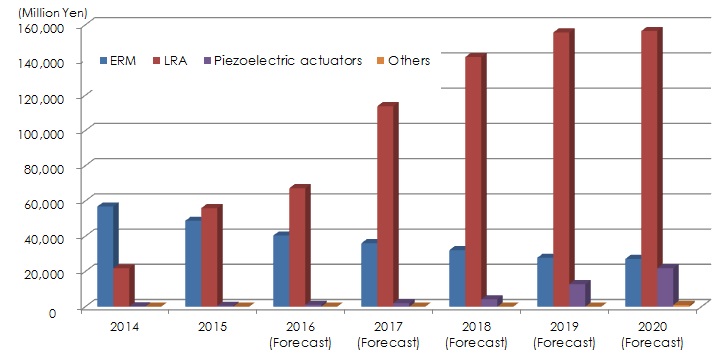Global Force Feedback (Haptic) Device Market: Key Research Findings 2017
Research Outline
- Research period: From October 2016 to January 2017
- Research targets: Makers of actuators for force feedback, driver ICs and software
- Research methodologies: Face-to-face interviews by the expert researchers, surveys via telephone and email, and literature research
What is Force Feedback (Haptic) Technology?
Force feedback or haptic technology gives some kind of tactile sensation to users by applying forces, vibrations, or motions to smartphones, game machine controllers and other input devices, in order to enhance realness to the virtual reality or simulated world.
What is the Force Feedback (Haptic) Device Market?
The force feedback devices in this research indicate the actuators, the main devices to make the force feedback functions real. Those actuators include ERM (Eccentric Rotation Mass,) LRA (Linear Resonant Actuators,) and piezoelectric actuators. The market size is calculated based on the purchase amount at smartphone makers, etc. The actuators with just a vibration function used for buzzers to call attention are not included.
Summary of Research Findings
- Global Force Feedback (Haptic) Device Market in 2017 Projected to Attain 151.922 Billion Yen, 139.7% of Size of Previous Year
As the wearable device market has gradually been launched in the form of smart bands, smartwatches, HMD (Head Mount Displays), rings, and clothing, the actuators for force feedback is likely to be increasingly adopted in such wearable devices, in addition to smartphones. This tendency is expected to expand the global market of force feedback (haptic) devices to attain 151.922 billion yen in 2017, 139.7% of the size of the previous year.
- Ratio of LRA Likely to Occupy Maximum 74.9% of Global Force Feedback (Haptic) Device Market in 2017
Although there are ERM, LRA, piezoelectric actuators, and etc. in force feedback (haptic) devices, the major actuators of force feedback devices have mainly been ERM because of their simple driving circuit, smallness in size, and low price. However, the actuators are recently needed to be more superior and have larger vibration, which is increasing the adoptions of LRA regardless of its higher unit price, and replacing ERM installations mainly in smartphones. As this seems to continue for the time being, the ratio of LRA in 2017 is likely to occupy up to 74.9% of the global force feedback (haptic) device market.
- CAGR of Global Force Feedback (Haptic) Device Market from 2016 to 2020 Attains 17.4%, with Market Size in 2020 to Exceed 200 Billion Yen
The global force feedback (haptic) device market is expected to continue growing for the future, as piezoelectric actuators started being adopted in vehicle application, in association with the growing adoptions of LRA in spite of their high unit price. The CAGR of the market from 2016 to 2020 is likely to attain 17.4%, with the market size projected to achieve 206.467 billion yen by 2020.
- Figure 1: Transition and Forecast of Global Force Feedback (Haptic) Device Market Size
